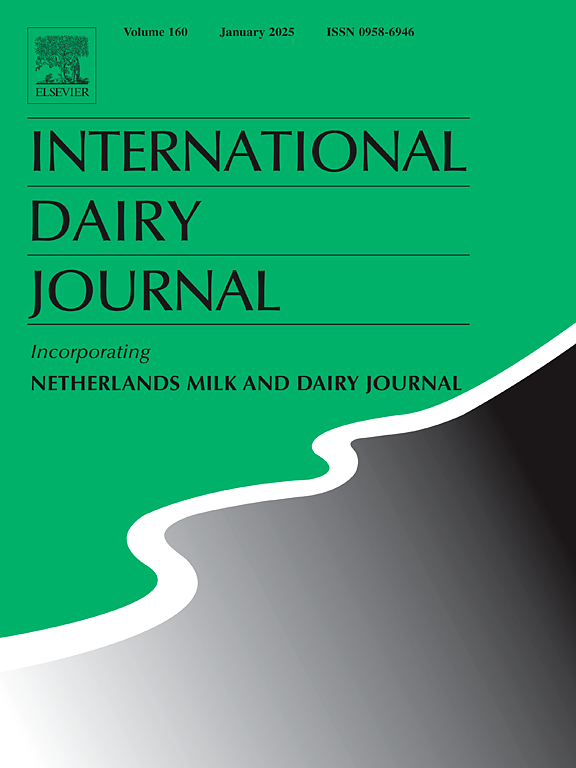高压均质对不同酸化剂酸化牛奶理化性质的影响
IF 3.4
3区 农林科学
Q2 FOOD SCIENCE & TECHNOLOGY
引用次数: 0
摘要
本研究以葡萄糖- δ内酯(GDL)、乳酸(LA)或柠檬酸(CA)为酸化剂,研究了pH为5.50时高压均质(HPH)对酸化牛奶理化性质的影响。在天然pH下,HPH处理对牛奶的血清离子钙([Ca2+])没有显著影响,但会导致ca酸化牛奶的大量减少(0.96 mM;19.5%),其次是LA (0.52 mM;7.78%)和gdl酸化乳(0.36 mM;6.53%)。GDL和LA经HPH处理后的表观粘度下降与GDL和LA样品的酪蛋白胶束大小增加有关,而CA样品基本不变。酪蛋白在血清期由于酸化而分裂,前者在HPH处理后进一步重新组装。与CA相比,GDL和LA在HPH过程中导致血清期个体酪蛋白大小的减少更为显著,κ-酪蛋白减少46.6 - 38.3%,α-酪蛋白减少50.4 - 62.0%,β-酪蛋白减少31.3 - 36.5%。本研究提供的信息显示了调节物理化学性质(即粘度降低,[Ca2+],颗粒大小)的潜力,因此,酸化牛奶的功能将用于制造乳制品。本文章由计算机程序翻译,如有差异,请以英文原文为准。
The effect of high-pressure homogenisation on the physicochemical properties of milk acidified using different acidulants
This study investigates the effects of high-pressure homogenisation (HPH) on the physicochemical properties of acidified milk at pH 5.50, using glucono-delta-lactone (GDL), lactic acid (LA), or citric acid (CA) as acidulants. HPH treatment did not significantly influence serum ionic calcium ([Ca2+]) of milk at native pH, however induced a large reduction on CA-acidified milk (0.96 mM; 19.5 %), followed by LA (0.52 mM; 7.78 %) and GDL-acidified milk (0.36 mM; 6.53 %). A decrease of apparent viscosity observed after HPH for GDL and LA was associated with an increase in casein micelles size for GDL and LA samples, while the CA sample was largely unchanged. Caseins are partitioned in the serum phase due to acidification, with the former being further re-assembly after HPH processing. Compared with CA, GDL and LA results in a more significant reduction of individual casein size in the serum phase with a reduction of 46.6–38.3 % for κ-casein, 50.4–62.0 % for α-casein and 31.3–36.5 % for β-casein after HPH process. The information provided in this study shows the potential to modulate the physicochemical properties (i.e., viscosity reduction, [Ca2+], particle size) and, thus, the functionality of acidified milk to be used in manufacturing dairy products.
求助全文
通过发布文献求助,成功后即可免费获取论文全文。
去求助
来源期刊

International Dairy Journal
工程技术-食品科技
CiteScore
6.50
自引率
9.70%
发文量
200
审稿时长
49 days
期刊介绍:
The International Dairy Journal publishes significant advancements in dairy science and technology in the form of research articles and critical reviews that are of relevance to the broader international dairy community. Within this scope, research on the science and technology of milk and dairy products and the nutritional and health aspects of dairy foods are included; the journal pays particular attention to applied research and its interface with the dairy industry.
The journal''s coverage includes the following, where directly applicable to dairy science and technology:
• Chemistry and physico-chemical properties of milk constituents
• Microbiology, food safety, enzymology, biotechnology
• Processing and engineering
• Emulsion science, food structure, and texture
• Raw material quality and effect on relevant products
• Flavour and off-flavour development
• Technological functionality and applications of dairy ingredients
• Sensory and consumer sciences
• Nutrition and substantiation of human health implications of milk components or dairy products
International Dairy Journal does not publish papers related to milk production, animal health and other aspects of on-farm milk production unless there is a clear relationship to dairy technology, human health or final product quality.
 求助内容:
求助内容: 应助结果提醒方式:
应助结果提醒方式:


